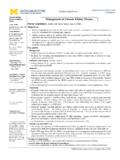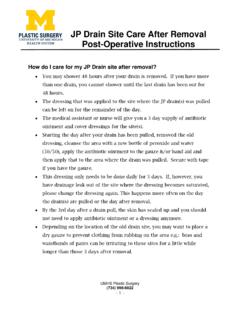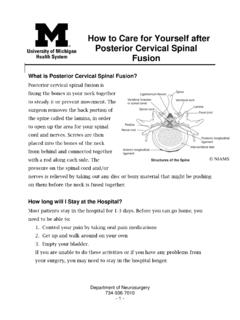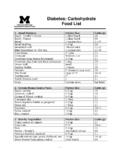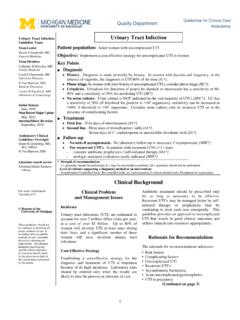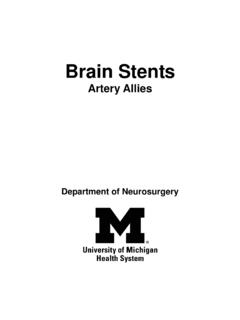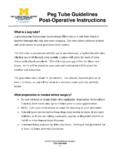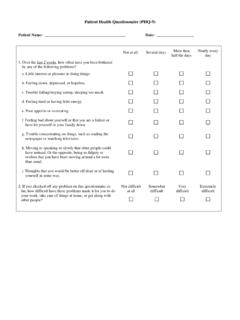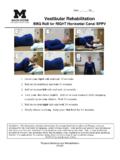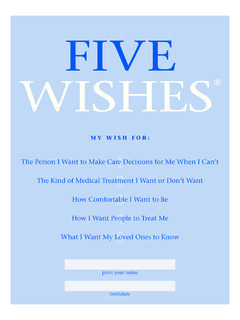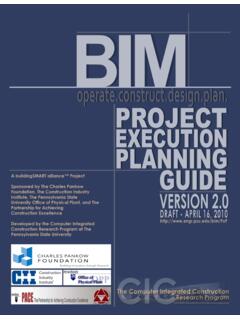Transcription of Start the Conversation: Making your health care wishes known
1 Start the Conversation: Making your health care wishes known Advance Directives and Durable Power of Attorney for health Care 1 Advance Directive Toolkit This toolkit has five parts. It lets you: Before You Begin: Learn about Advance Directives. (Page 3) This section helps you to learn about planning for health care and the forms that you need to complete. Form Part A: Make your health care wishes known . (Page 8) This form lets you write down the kind of health care you want to help guide your Patient Advocate. This way, those who care for you will not have to guess what you want if you are too sick to tell them yourself.
2 Form Part B: Choose a Patient Advocate. (Page 14) A Patient Advocate is a person who can make medical decisions for you if you are too sick or unable to make them yourself. Form Part C: Sign the form. (Page 15) You must sign the form before it can be used. Form Part D: Ask your Patient Advocate to sign. (Page 17) Your Patient Advocate must sign on page 17 to agree to be your Patient Advocate. Fill out only the parts you want. If you only want to list your own health care wishes go to Part A (Page 8). If you only want to name a Patient Advocate go to Part B (Page 14). If you want both then fill out Part A and Part B.
3 Always sign the form with 2 witnesses in Part C (Page 15). 2 Advance Directives Checklist Use this checklist as a helpful guide when considering your preferences and completing the forms in this booklet. Read this toolkit cover to cover. Write down all your questions. Discuss your questions with your doctors, family, friends and spiritual advisers. Identify a person to serve as your Patient Advocate (and an alternate Patient Advocate). Talk with this person and make sure that they are willing to serve as your Patient Advocate. Tell them about your wishes . Complete Part A (Make Your health Care wishes known ) and Part B (Appoint a Patient Advocate) of this toolkit.
4 Identify 2 people who are not your Patient Advocate, your family members or part of your health care team who can serve as witnesses. Sign the form in front of the witnesses. Have the witnesses sign the form. Have your Patient Advocate sign the form. Make several copies of the signed form. Save a copy for yourself. Keep it in a safe and easily accessible place. Give copies to your Patient Advocate, health care provider, family, and friends. Review this document regularly 3 Before You Begin Why is planning for health care important? You always have the right to be included in any decisions related to the health care you receive.
5 However, no one knows what the future holds, and there may be a time when you are unable to make your own decisions. By reviewing this toolkit and stating your wishes for health care, you can make sure that people close to you and people who provide health care for you know what types of decisions you would make for yourself. How can I Start ? Writing down your preferences is a good way to Start planning for your health care. An Advance Directive is a written statement about your wishes regarding medical treatment. In the State of Michigan, the Durable Power of Attorney for health Care (DPOA-HC) form is the most widely used Advance Directive.
6 The DPOA-HC allows you to name your Patient Advocate and is a legal document in Michigan. What is a Patient Advocate? A Patient Advocate is the person who can make medical decisions for you if you are too sick or unable to make them yourself. Naming a Patient Advocate is your DPOA-HC. A Patient Advocate can only make your medical decisions if 2 doctors agree that you cannot make your own decisions and this is written in your record. Your Patient Advocate will make decisions that you would be asked to make if you were able. Whom should I choose to be my Patient Advocate? A family member or friend who: Is at least 18 years old.
7 Knows you well. Can be there for you when you need them. You trust to do what is best for you and follow your wishes , even if they do not agree with your wishes . Can tell your doctors about your health care wishes . 4 What will happen if I do not choose a Patient Advocate? If you are too sick to make your own decisions, your doctors may ask your closest family members to make decisions for you. If your family members cannot make a decision or agree on a decision, then a judge may appoint someone to make decisions for you. You will receive care even if you do not choose a Patient Advocate. What kind of decisions can my Patient Advocate make?
8 Based on your wishes , your Patient Advocate can: agree to, say no to, change, stop or choose any of the following: Doctors, nurses, social workers Hospitals or clinics Medications, tests, or treatments Whether or not you receive life support treatments Whether or not you receive surgery Whether or not to take you to a hospital or nursing home What kind of comfort care you receive, including hospice care Your Patient Advocate may look at your medical records to help make these decisions. The law defines your Patient Advocate named in your DPOA-HC as your surrogate decision maker. This means that they will make medical decisions for you.
9 This is why it is very important to share your wishes with your Patient Advocate. The preferences you write down on this form should serve as a guide for your Patient Advocate and doctors, but they are not legally binding. A properly completed DPOA-HC is legally recognized and allows your Patient Advocate to make medical decisions for you when you cannot. 5 What do I do with the form after I fill it out and everyone has signed? Bring a copy of this form to your doctor s office or hospital so it can be scanned into your medical record. Share a copy of the form with others who care for you, such as: o Your Patient Advocate o All of your doctors o Nurses o Social workers o Family and friends Keep a copy for yourself in a safe and easy to find place.
10 Talk with your Patient Advocate about your choices. Can I change my mind? You can change your mind at any time. Any spoken wish about a medical treatment must be honored by a Patient Advocate, even if it is different than what you put in your form. If you change your mind, it is best to fill out and sign a new form. o Tell those who care for you about your changes. o Give the new form to your Patient Advocate and your doctors. What if I have questions about the form? Bring it to your doctors, nurses, social workers, Patient Advocate, family or friends to answer your questions. What if I want to write down health care wishes that are not on this form?
